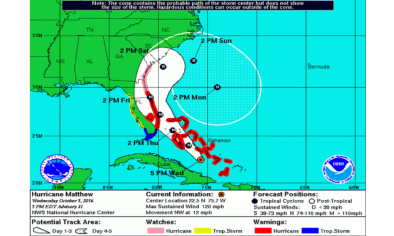Headline
North Carolina flooding proves we need a new way of rating hurricanes
United States

Anthony Writebol, left, and his cousin, Melissa Hill paddle past a stranded tractor trailer on Hwy 211 in Lumberton, N.C., Sunday, Oct. 9, 2016. Photo: Chuck Liddy, The Charlotte Observer via AP
"The most widespread threat is heavy rains and flooding," said [Kevin Trenberth, a senior scientist at the National Center for Atmospheric Research (NCAR)], noting that the size of the rainfall threat is related to the size of the storm and the temperature of the ocean where the storm is drawing its energy from.
With Hurricane Matthew, Trenberth said the sea surface temperatures were more than 2 degrees Celsius, or 3.6 degrees Fahrenheit, above average for this time of year, across a broad region that the storm drew moisture from.
This added more water vapor to the air, which eventually condensed and fell as torrential rain in the Carolinas.
Related Content
Headline

Nov 10, 2016 | Reuters
Living in the aftermath of Hurricane Matthew
Headline

Nov 8, 2016 | Financial Times
A 19th century plague revived in an age of climate change
Headline

Nov 7, 2016 | Robert Scribbler
Dangerous Hurricane Matthew Strengthens in Record Hot Environment
Headline

Nov 7, 2016 | KRQE via Associated Press
Hurricane Matthew brought town’s demise, needs a ‘miracle’


